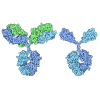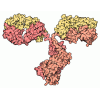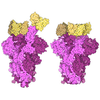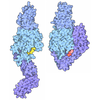[English] 日本語
 Yorodumi
Yorodumi- PDB-9nrj: abTCR bound to SAR444200, a novel anti-GPC3 T-cell engager, for t... -
+ Open data
Open data
- Basic information
Basic information
| Entry | Database: PDB / ID: 9nrj | ||||||
|---|---|---|---|---|---|---|---|
| Title | abTCR bound to SAR444200, a novel anti-GPC3 T-cell engager, for the treatment of GPC3+ solid tumors | ||||||
 Components Components |
| ||||||
 Keywords Keywords | IMMUNE SYSTEM / TCR / T-cell receptor / NANOBODY | ||||||
| Function / homology |  Function and homology information Function and homology informationT cell activation involved in immune response / T cell receptor complex / adaptive immune response / cell surface Similarity search - Function | ||||||
| Biological species |  Homo sapiens (human) Homo sapiens (human) | ||||||
| Method | ELECTRON MICROSCOPY / single particle reconstruction / cryo EM / Resolution: 3.4 Å | ||||||
 Authors Authors | Svidritskiy, E. / Qiu, Y. / Yanfeng, Z. | ||||||
| Funding support | 1items
| ||||||
 Citation Citation |  Journal: Mol Cancer Ther / Year: 2025 Journal: Mol Cancer Ther / Year: 2025Title: Identification and non-clinical characterization of SAR444200, a novel anti-GPC3 NANOBODY® T-cell engager, for the treatment of GPC3+ solid tumors. Authors: Paolo Meoni / Ana Paula B Vintém / Virna F Cortez-Retamozo / Jasper Jacobs / Evelyn De Tavernier / Paola Fiorentini / Diane Van Hoorick / Joseph D Batchelor / Egor Svidritskiy / Yu Qiu / ...Authors: Paolo Meoni / Ana Paula B Vintém / Virna F Cortez-Retamozo / Jasper Jacobs / Evelyn De Tavernier / Paola Fiorentini / Diane Van Hoorick / Joseph D Batchelor / Egor Svidritskiy / Yu Qiu / Eline Dejonckheere / Aiqun Li / Lily I Pao / Marie-Ange Buyse /    Abstract: T-cell engager (TCE) immunotherapy has demonstrated significant clinical activity in multiple cancers by inducing co-engagement of T-cells and tumor cells, resulting in T-cell activation and T-cell- ...T-cell engager (TCE) immunotherapy has demonstrated significant clinical activity in multiple cancers by inducing co-engagement of T-cells and tumor cells, resulting in T-cell activation and T-cell-dependent cellular cytotoxicity (TDCC) against tumor cells. Current-generation TCEs are predominantly composed of antibody-based binding domains targeting the CD3e molecule of the T-cell antigen receptor (TCR)/CD3 complex on T-cells and a tumor-associated antigen on tumor cells. However, limitations of this approach include cytokine release syndrome and a limited therapeutic window. Here, we report the generation and preclinical evaluation of SAR444200, the first NANOBODY®-based TCE clinical candidate binding to TCRαβ and GPC3 to co-engage T-cells and GPC3+ tumor cells, causing TDCC. SAR444200 bound with nanomolar to picomolar affinity to TCRαβ and GPC3 respectively and induced in vitro TDCC against multiple human tumor cell lines with differential GPC3 expression with picomolar potency. In vivo analysis using human cancer cell line-derived (HuH-7 and HepG2) xenografts in immunodeficient mice showed complete tumor regression at doses starting from 0.7 mg/kg. In exploratory non-human primate studies, intravenous administration of SAR444200 was well tolerated up to 8 mg/kg and exhibited greater than dose-proportional clearances and dose-proportional maximum concentrations across the tested dose range. The highly potent and efficacious activity of SAR444200 in diverse models of GPC3+ tumors and the extremely wide tolerated dose range merits further development of this compound. Furthermore, NANOBODY®-based TCEs developed using an anti-TCRαβ moiety may have specific advantages for the development of TCEs. | ||||||
| History |
|
- Structure visualization
Structure visualization
| Structure viewer | Molecule:  Molmil Molmil Jmol/JSmol Jmol/JSmol |
|---|
- Downloads & links
Downloads & links
- Download
Download
| PDBx/mmCIF format |  9nrj.cif.gz 9nrj.cif.gz | 177 KB | Display |  PDBx/mmCIF format PDBx/mmCIF format |
|---|---|---|---|---|
| PDB format |  pdb9nrj.ent.gz pdb9nrj.ent.gz | 120.1 KB | Display |  PDB format PDB format |
| PDBx/mmJSON format |  9nrj.json.gz 9nrj.json.gz | Tree view |  PDBx/mmJSON format PDBx/mmJSON format | |
| Others |  Other downloads Other downloads |
-Validation report
| Summary document |  9nrj_validation.pdf.gz 9nrj_validation.pdf.gz | 1.3 MB | Display |  wwPDB validaton report wwPDB validaton report |
|---|---|---|---|---|
| Full document |  9nrj_full_validation.pdf.gz 9nrj_full_validation.pdf.gz | 1.6 MB | Display | |
| Data in XML |  9nrj_validation.xml.gz 9nrj_validation.xml.gz | 71.5 KB | Display | |
| Data in CIF |  9nrj_validation.cif.gz 9nrj_validation.cif.gz | 91.9 KB | Display | |
| Arichive directory |  https://data.pdbj.org/pub/pdb/validation_reports/nr/9nrj https://data.pdbj.org/pub/pdb/validation_reports/nr/9nrj ftp://data.pdbj.org/pub/pdb/validation_reports/nr/9nrj ftp://data.pdbj.org/pub/pdb/validation_reports/nr/9nrj | HTTPS FTP |
-Related structure data
| Related structure data |  49735MC  9bdoC  9ntqC M: map data used to model this data C: citing same article ( |
|---|---|
| Similar structure data | Similarity search - Function & homology  F&H Search F&H Search |
- Links
Links
- Assembly
Assembly
| Deposited unit | 
|
|---|---|
| 1 |
|
- Components
Components
-M1-specific T cell receptor ... , 2 types, 2 molecules AB
| #1: Protein | Mass: 21782.236 Da / Num. of mol.: 1 Source method: isolated from a genetically manipulated source Source: (gene. exp.)  Homo sapiens (human) / Gene: TRA / Production host: Homo sapiens (human) / Gene: TRA / Production host:  Homo sapiens (human) / References: UniProt: P0DSE1 Homo sapiens (human) / References: UniProt: P0DSE1 |
|---|---|
| #2: Protein | Mass: 27555.459 Da / Num. of mol.: 1 Source method: isolated from a genetically manipulated source Source: (gene. exp.)  Homo sapiens (human) / Gene: TRB / Production host: Homo sapiens (human) / Gene: TRB / Production host:  Homo sapiens (human) / References: UniProt: P0DSE2 Homo sapiens (human) / References: UniProt: P0DSE2 |
-Protein / Antibody , 2 types, 2 molecules CT
| #3: Protein | Mass: 12562.209 Da / Num. of mol.: 1 Source method: isolated from a genetically manipulated source Source: (gene. exp.)  Homo sapiens (human) / Production host: Homo sapiens (human) / Production host:  Homo sapiens (human) Homo sapiens (human) |
|---|---|
| #4: Antibody | Mass: 13061.505 Da / Num. of mol.: 1 Source method: isolated from a genetically manipulated source Source: (gene. exp.)  Homo sapiens (human) / Production host: Homo sapiens (human) / Production host:  Homo sapiens (human) Homo sapiens (human) |
-Sugars , 3 types, 3 molecules
| #5: Polysaccharide | 2-acetamido-2-deoxy-beta-D-glucopyranose-(1-4)-[alpha-L-fucopyranose-(1-6)]2-acetamido-2-deoxy-beta- ...2-acetamido-2-deoxy-beta-D-glucopyranose-(1-4)-[alpha-L-fucopyranose-(1-6)]2-acetamido-2-deoxy-beta-D-glucopyranose Source method: isolated from a genetically manipulated source |
|---|---|
| #6: Polysaccharide | beta-D-mannopyranose-(1-4)-2-acetamido-2-deoxy-beta-D-glucopyranose-(1-4)-2-acetamido-2-deoxy-beta- ...beta-D-mannopyranose-(1-4)-2-acetamido-2-deoxy-beta-D-glucopyranose-(1-4)-2-acetamido-2-deoxy-beta-D-glucopyranose Source method: isolated from a genetically manipulated source |
| #7: Polysaccharide | 2-acetamido-2-deoxy-beta-D-glucopyranose-(1-4)-2-acetamido-2-deoxy-beta-D-glucopyranose Source method: isolated from a genetically manipulated source |
-Details
| Has ligand of interest | N |
|---|---|
| Has protein modification | Y |
-Experimental details
-Experiment
| Experiment | Method: ELECTRON MICROSCOPY |
|---|---|
| EM experiment | Aggregation state: 2D ARRAY / 3D reconstruction method: single particle reconstruction |
- Sample preparation
Sample preparation
| Component | Name: TCRab / Type: COMPLEX / Entity ID: #1-#4 / Source: RECOMBINANT |
|---|---|
| Molecular weight | Experimental value: NO |
| Source (natural) | Organism:  Homo sapiens (human) Homo sapiens (human) |
| Source (recombinant) | Organism:  Homo sapiens (human) Homo sapiens (human) |
| Buffer solution | pH: 7.4 |
| Specimen | Embedding applied: NO / Shadowing applied: NO / Staining applied: NO / Vitrification applied: YES |
| Vitrification | Cryogen name: ETHANE |
- Electron microscopy imaging
Electron microscopy imaging
| Experimental equipment |  Model: Titan Krios / Image courtesy: FEI Company |
|---|---|
| Microscopy | Model: TFS KRIOS |
| Electron gun | Electron source:  FIELD EMISSION GUN / Accelerating voltage: 300 kV / Illumination mode: SPOT SCAN FIELD EMISSION GUN / Accelerating voltage: 300 kV / Illumination mode: SPOT SCAN |
| Electron lens | Mode: BRIGHT FIELD / Nominal defocus max: 1200 nm / Nominal defocus min: 1200 nm |
| Image recording | Electron dose: 80 e/Å2 / Film or detector model: GATAN K2 QUANTUM (4k x 4k) |
- Processing
Processing
| CTF correction | Type: NONE |
|---|---|
| 3D reconstruction | Resolution: 3.4 Å / Resolution method: FSC 0.143 CUT-OFF / Num. of particles: 95366 / Symmetry type: POINT |
 Movie
Movie Controller
Controller



 PDBj
PDBj




